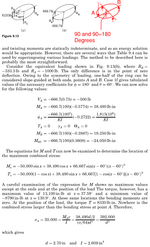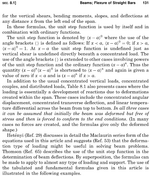Struct123ure
Structural
I have a curved steel beam very similar to the example attached from page 300 of 7th ed Textbook by Roark's ...
My question is that the solution values don't make sense.
1. If you plug x=37.59 and x=130.9 into the Tx formula you don't get 13,100 in-lb & 8790in-lb respectively. (I get from calculating in excel 18,137 & -8788 (close enough)). I would attribute this to a typo, but nothing works out.
T is not 8330lb-in at the load position (60 degrees) because (60-60)^0 is error....
"M shows a max value a the ends" that's not what happens when you input from 0-180 degrees into Mx equation...
Anyone who is either better at math or has delt with curved beams before can help me understand where I went wrong? I read the chapter, but feel like something is missing from this example

My question is that the solution values don't make sense.
1. If you plug x=37.59 and x=130.9 into the Tx formula you don't get 13,100 in-lb & 8790in-lb respectively. (I get from calculating in excel 18,137 & -8788 (close enough)). I would attribute this to a typo, but nothing works out.
T is not 8330lb-in at the load position (60 degrees) because (60-60)^0 is error....
"M shows a max value a the ends" that's not what happens when you input from 0-180 degrees into Mx equation...
Anyone who is either better at math or has delt with curved beams before can help me understand where I went wrong? I read the chapter, but feel like something is missing from this example


